Excerpts from Jim Conrad's
Naturalist Newsletter
entry from field notes dated January 19, 2023, taken along steep, one-lane gravel road ascending forested, northeast-facing mountain slope, elevation ±2,380m (7600 ft); bedrock of Cretaceous limestone; on the south side of Pinal de Amoles, Querétaro state, MÉXICO, (N21.134°, W99.629°)
SLIPPER FLOWER
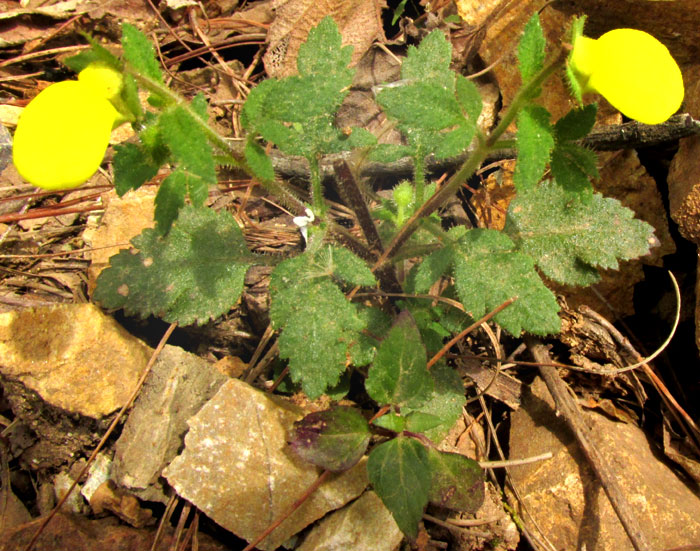
On a steep slope forested mostly with pines, the above hand-tall wildflower caught attention with its two yellow blossoms glowing as if they were yellow balloons with bright lights inside.
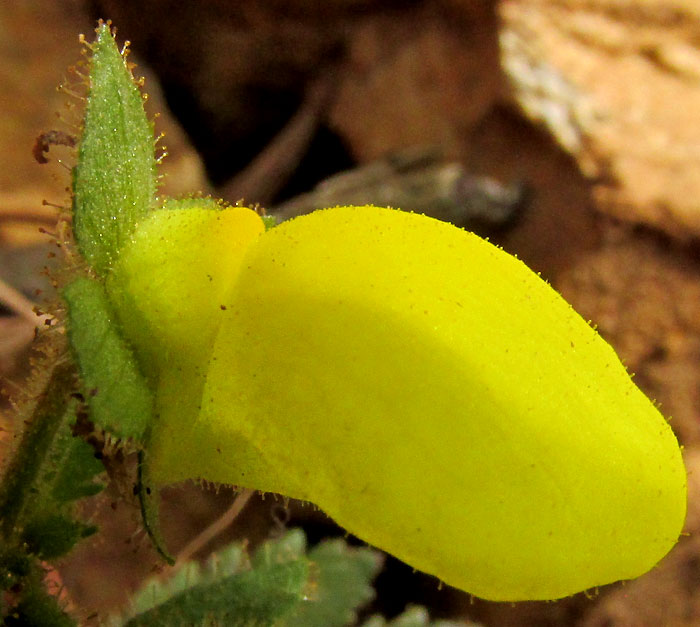
Up close, the corolla clearly was bilaterally symmetrical, but individual petals or corolla lobes were hard to decipher. The green structure at the above image's far left is the calyx with four egg-shaped sepals. The corolla's base arising from the calyx was a short, irregularly shaped tube with a slightly greenish-yellow color. The tube then divided into a very short top lip, appearing as no more than a small bulge at the corolla's top, and a tremendously inflated, sack-like lower lip. The sexual parts are entirely hidden within the inflated lower lip. When the blossom is more mature, the upper and lower lips separate a little, allowing bee pollinators to wedge themselves into the lower lip's sack and pollinate. Both calyx and corolla are invested with gland-tipped hairs.
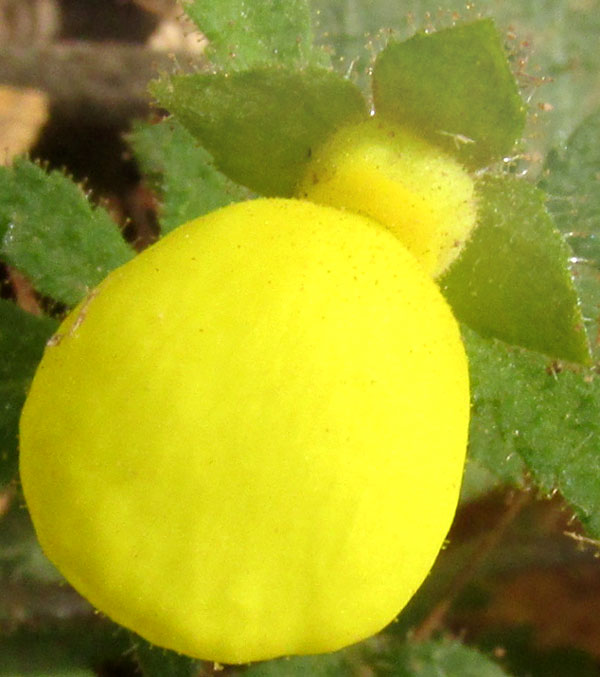
In the above picture, the flower seen from the front displays little more than its inflated, globe-shaped lower lip, and the much smaller upper lip above it.
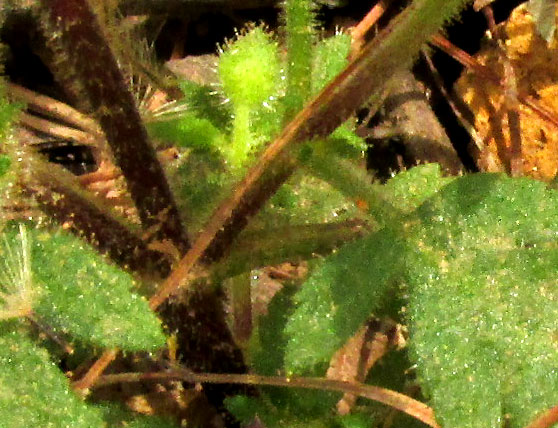
A close look at the basal stems, shown above, revealed a good field mark for determining our plant's family: The stems were squared in cross section. Here's a look at a typical leaf halfway up the stem:
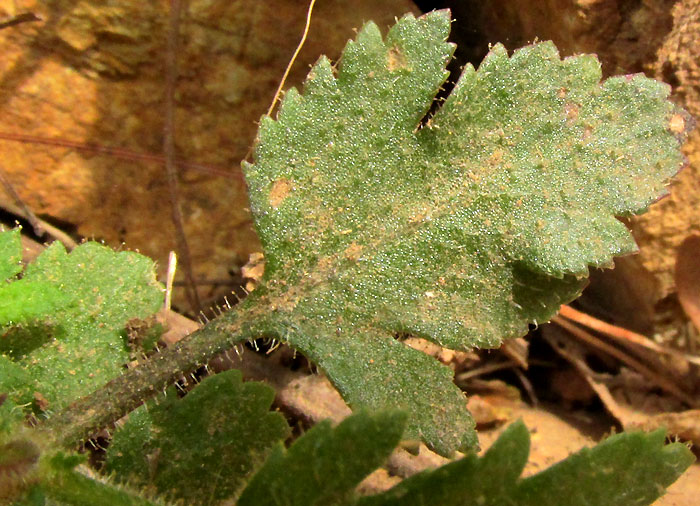
The two lipped corollas on an herb with squared stems strongly suggested something in the order Lamiales, taxonomic orders being groupings of closely related plant families. The three most commonly encountered families with those features are the Mint, Snapdragon and Acanthus Families. I couldn't think of anything in the Mint or Acanthus Families with such inflated corollas, but in the Snapdragon Family, the Scrophulariaceae, snapdragons, foxgloves and other family members often produce large, blousy blossoms and are more likely to be yellow, so the Snapdragon Family was a good starting point for identifying our plant.
In the old days, and still with certain authorities, that would have been the right guess. However, today genetic analysis is shifting things around. In short, today most experts assign our plant to a family first published in 2001, the Calceolariaceae, sometimes known as the Slipper Flower Family, because of its blossoms' vague slipper shapes. Currently the family includes three genera, of which our plant belongs to the genus Calceolaria. That genus comprises about 388 species, occurring only in the Americas, from here in central Mexico south to Argentina, and its center of diversity is the Andes.
Those who grow potted houseplants with colorful flowers might have recognized our plant as what's often sold as Slipper Flowers, Calceolarias, Lady's Purses, Slipperworts and other such names, all species and cultivars, often hybrids, of the genus Calceolaria.
The Flora del Bajío, which covers our upland, central Mexican region, published its volume documenting Calceolaria in 2011, and recognizes two Calceolaria species found here: Calceolaria mexicana and Calceolaria tripartita. Both species have been collected near Pinal de Amoles. The two species are described as very variable, or polymorphic, they occupy similar habitats, they occur within similar distribution areas, and unless you notice that the lower cell, or locule, of the anther of Calceolaria mexicana is fertile, while in Calceolaria tripartita it's sterile and somewhat atrophied, it can be hard to distinguish the two species. In fact, despite both names currently being accepted, I suspect that eventually someone will lump the two species. Moreover, the resulting larger species will be known as Calceolaria tripartita, because that name was first published in 1798, while the name Calceolaria mexicana wasn't published until 1839.
I'm calling our plant CALCEOLARIA TRIPARTITA not only for that reason, but also because on the Internet the general forms and sizes of our plant's sepals, corolla and leaves more often match those of that species than C. mexicana, though there's plenty of overlap. Both species can form dense, spreading bushes up to a meter tall (3.3ft), so our plant is a young one, plus it's growing in an especially shaded location. Such an individual well might bear parts of different sizes and shapes than older plants growing in more sunlight. Choosing the name Calceolaria tripartita, then, feels just a little iffy.
In English, our plant -- along with all the other Calceolaria species -- can be called Slipper Flower, as well as several other such names relating to the flowers' shape. In Mexican Spanish our Calceolaria tripartita often is known as Zapatitos de la Virgen, or "The Virgin's Little Shoes." Otherwise, there's not much documentation regarding this plant's importance or uses.